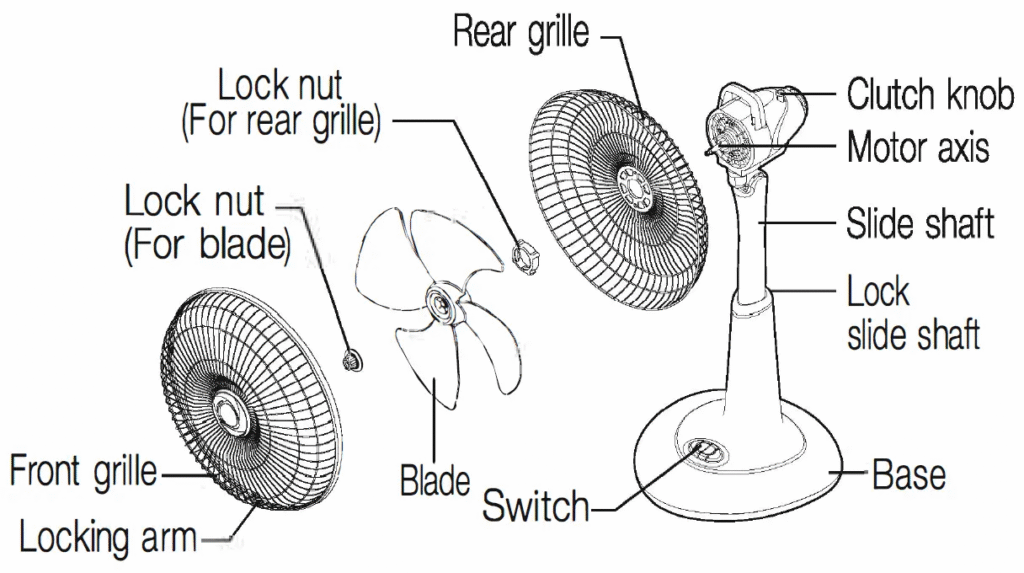Electric fan parts are crucial components that come together to deliver the cool breeze we rely on in homes, offices, and industrial spaces. Whether you’re performing maintenance, repairing a faulty fan, or just curious about how these machines work, understanding the function and structure of each component can significantly improve your troubleshooting skills and ensure your fan stays operational for years.
In this guide, we’ll explore the major electric fan parts, their purposes, common issues, and how they all interact to keep your space ventilated and comfortable.
The Core Components of Electric Fan Parts
To grasp the mechanics of electric fans, it’s essential to know what lies beneath the surface. The design may vary depending on the fan type (ceiling, pedestal, table, exhaust), but many electric fan parts are universally found in most models.
1. Motor: The Heart of the Electric Fan
At the center of every electric fan is the motor. This is one of the most vital electric fan parts, converting electrical energy into mechanical energy that spins the blades. Most fan motors are induction motors, known for their efficiency and durability. Overheating, power surges, or dust accumulation can lead to motor failure, making proper cleaning and voltage regulation key to long life.
2. Fan Blades: The Movers of Air
Fan blades are the most visible and recognizable electric fan parts. Typically made from plastic, metal, or composite materials, their design directly impacts airflow. Blade angle, length, and shape determine the fan’s efficiency. Bent or unbalanced blades can cause wobbling, noise, or even damage to the motor over time.
3. Shaft and Bearings: The Connective Pathway
The motor transfers rotational force to the blades via a shaft. Bearings allow this shaft to spin smoothly with minimal friction. These electric fan parts must be kept lubricated, or you risk grinding noises and motor strain. In ceiling fans or industrial models, ball bearings are common due to their durability under constant motion.
4. Capacitor: The Power Booster
Among lesser-known but critical electric fan parts is the capacitor. This component helps start and regulate the motor’s speed. If your fan fails to start or runs at inconsistent speeds, a faulty capacitor is a likely culprit. It stores energy and releases it during startup, giving the fan the extra torque needed to spin the blades.

5. Oscillating Mechanism: The Motion Manager
In oscillating fans, this mechanism is what allows the head of the fan to move from side to side. It’s one of the more mechanical electric fan parts, consisting of gears, arms, and a small motor. Malfunctions here often result in a stationary fan head or irregular movement.
6. Control Panel or Switches: The Command Center
Switches, knobs, or digital control panels are user interfaces that allow control over speed and oscillation. These electric fan parts may be mechanical (manual switches) or electronic (touch panels). Over time, frequent usage can wear out contacts, leading to unresponsive controls.
7. Housing and Grill: Safety Meets Aesthetics
The external casing and safety grill are electric fan parts that serve protective and aesthetic functions. They shield internal components from dust and damage while preventing accidental contact with the spinning blades. Regular cleaning of the grill ensures uninterrupted airflow.
8. Power Cord and Plug: The Lifeline
Power cords might seem simple, but they’re vital electric fan parts. A damaged cord can cause short circuits or electric shocks. Always inspect for fraying or exposed wires and replace them as soon as damage is noticed.
Maintenance Tips for Electric Fan Parts
Proper care of electric fan parts can extend the fan’s lifespan significantly. Here are essential tips:
- Dust regularly: Prevent build-up on blades and motor vents.
- Lubricate bearings: Apply light machine oil periodically to avoid friction.
- Check connections: Loose wires or screws can lead to malfunctions.
- Replace faulty capacitors or switches: These are often easy DIY fixes.
- Store properly during off-seasons: Keep your fan covered and stored in a dry area.
When to Replace Electric Fan Parts
Eventually, wear and tear will demand replacement. Common signs include strange noises, reduced airflow, irregular oscillation, or failure to power on. Fortunately, most electric fan parts can be purchased individually, saving the cost of buying a whole new fan. Always check compatibility with your model before purchasing.
Final Thoughts
Every component, from the motor to the blades, plays a specific role in keeping an electric fan operational. Understanding electric fan parts not only helps you maintain your device better but also empowers you to perform minor repairs yourself. With proper care and attention, your fan can offer years of reliable cooling, even in the hottest months.
